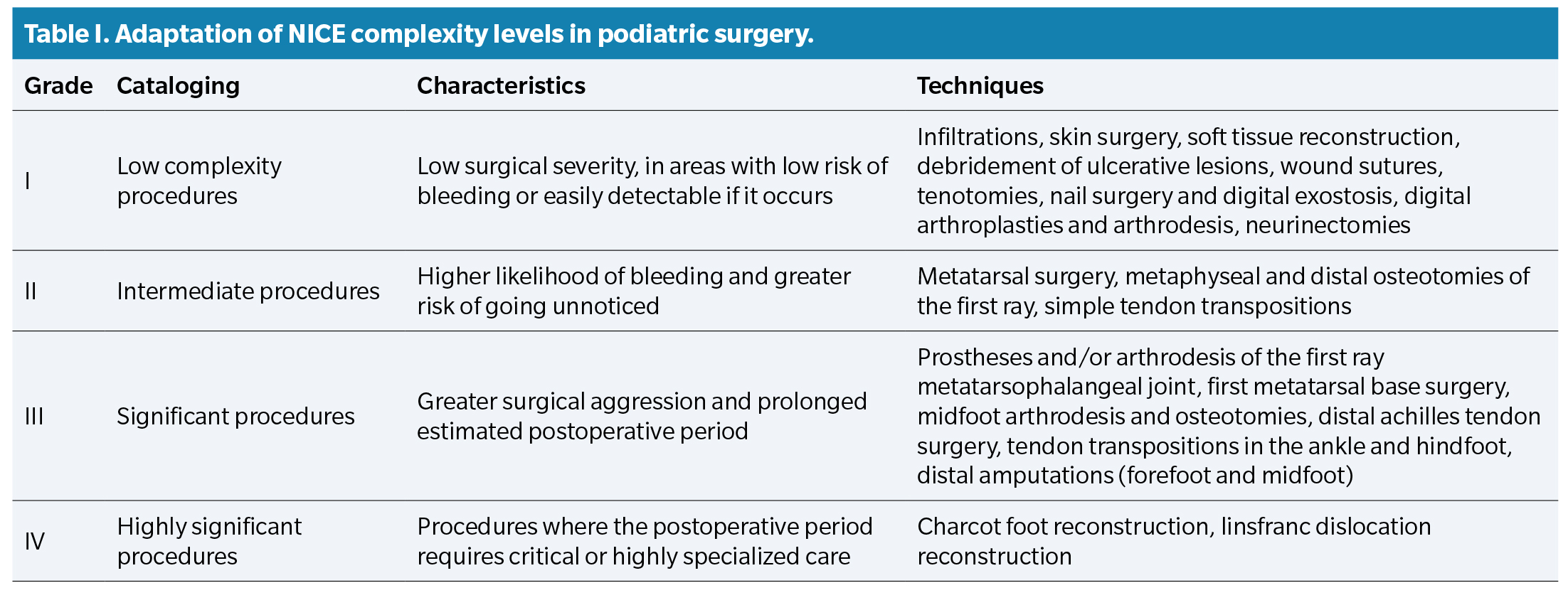
DOI: http://dx.doi.org/10.20986/revesppod.2024.1685/2024
LETTER TO THE EDITOR
Proposal for a classification of podiatric surgery techniques according to their degree of complexity
Propuesta de una clasificación de las técnicas de cirugía podológica según su grado de complejidad
Dionisio Martos Medina1
1Podólogo, Experto en Peritaje Judicial, Escuela Medicina Legal, Universidad Complutense de Madrid, España
Correspondence: Dionisio Martos Medina
Dmartos@telefonica.net
Received: 01-08-2024
Accepted: 05-21-2024
Dear Editor:
The General Council of Podiatrists, with the intention of defining the cornerstone of surgical competencies within podiatric surgery, approved the following definition during their General Assembly held in Madrid on May 6th, 2011: Podiatric surgery: “These are the surgical procedures performed by the podiatrist using standardized techniques aimed at the treatment of foot diseases and deformities for diagnostic, therapeutic, and/or prognostic purposes”.
Since podiatric surgery includes a significant number of techniques of varying complexity, ranging from basic surgical approaches such as infiltrative therapies, skin and associated organ surgeries to joint reconstructions, large joint arthrodesis, tendon transpositions, or addressing osteoarticular disease in Charcot neuroarthropathy, it is known that the White Paper on the Degree in Podiatry includes podiatric surgery within its competencies. However, the structuring of the degree curriculum includes the common content of “Chiropodology. Podiatric Surgery”, but lacks a classification of surgical procedures. The present document aims to ensure the quality of competencies and the services provided by podiatrists in Spain to patients and society. It is proposed, as also reflected in a position document by the Spanish Association of Podiatric Surgery, to establish a classification of surgical procedures based on the complexity of the various techniques inherent to the profession as a health care field qualified for the management of foot diseases and deformities. There are no legal limitations for performing these procedures, except for the anatomical boundaries of the foot and ankle as stipulated by Spanish state regulations.
This classification aims to facilitate preoperative evaluation and follows the preoperative guide of the NHS National Institute for Clinical Excellence (NICE), which categorizes surgeries into 4 levels based on the estimation of severe or unexpected hemorrhage, surgical time, postoperative care, and subsequent recovery.
With advancements in approaches and the complexity of podiatric surgical techniques, a system for classifying the degree of complexity is necessary for use by podiatrists in a variety of applications. This classification can be primarily used in studies and research for descriptive purposes and in efforts to classify various conditions and injuries to predict treatment outcomes and prevent potential complications from the application of the technique.
For a classification system to be effective, it must be easily reproducible to ensure high inter-observer reliability. With the advent of advanced podiatric surgical techniques, it has become more crucial to be precise in surgical planning, as there is an increasingly demanding need for podiatrists to have precise preoperative planning.

This document proposes the adoption of the following classification system for planning foot and ankle surgery to facilitate decision-making regarding approaches and attention to various surgical processes. There is an obvious difference in infrastructure, material and human resources, and pre, intra, and postoperative care among the various levels of complexity described in the following table. This document could be considered the beginning of research into this classification, as further development with reviews and updates will undoubtedly be required as techniques evolve.
Recomended References